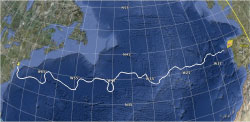"There's nothing like a robot at sea to get you excited."
|
||
Track of the Scarlet Knight |
The technical hurdles that had to be overcome were substantial: increase glider endurance by a factor of 10, modify the design, increase battery power, battle biofouling. After numerous shorter test flights, RU 17 departed from New Jersey – and was lost just short of the Azores. Further modifications complete, RU 27, the Scarlet Knight, was put in the ocean off the New Jersey coast on April 27, 2009 and successfully recovered off the coast of Spain on December 4, to be triumphantly brought into the town where the Pinta first returned with news of the new world.
RU COOL students were involved in every step along the way. "Atlantic Crossing was funded as an education program, not a research program," says Scott. Each student on the team was responsible for a specific aspect of the long-duration flight: construction and testing, flight characteristics, the HF radar network, path planning, website portal, blog and Google Earth interface. The purchase of the glider itself was funded by a group of Rutgers alumni who wanted to help engage students in ocean observatories.
|
This year Scott's students are working with the Cook glider, the next phase in Scott's plan to fly all the way around the world with a coordinated fleet of gliders. Cook is a thermal glider, funded by Office of Naval Research. The manufacturer, Teledyne Webb, gave Scott the keys, asking him to let his students take over and fly it. He estimates that Cook has a two-year lifespan. "We’ll just have class after class continue to fly Cook around the globe," says Scott. "We’ll start by crossing the Atlantic."
|
|



